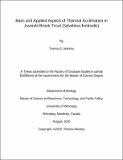| dc.contributor.author | Mackey, Theresa E. | |
| dc.date.accessioned | 2020-08-14T16:39:45Z | |
| dc.date.available | 2020-08-14T16:39:45Z | |
| dc.date.issued | 2020-08-06 | |
| dc.identifier.citation | Mackey, Theresa E. Basic and Applied Aspects of Thermal Acclimation in Juvenile Brook Trout (Salvelinus fontinalis); A Thesis submitted to the Faculty of Graduate Studies in partial fulfillment of the requirements for the Master of Science Degree, Department of Biology, Master of Science in Bioscience, Technology, and Public Policy, University of Winnipeg. Winnipeg: University of Winnipeg, August 2020. | en_US |
| dc.identifier.uri | http://hdl.handle.net/10680/1822 | |
| dc.description.abstract | Rising water temperatures are affecting the health and distribution of aquatic organisms. Brook trout (Salvelinus fontinalis), a popular freshwater sport fish adapted to cooler environments, is at risk to high temperature due to its habitat preferences. Using six acclimation temperatures that span the thermal distribution of the species (5C, 10C, 15C, 20C, 23C, and 25C), I quantified the stress response of juvenile brook trout by measuring physiological and molecular parameters to understand the processes that occur when fish are thermally stressed. Evidence of a stress response was apparent via exposure to a range of temperatures outside their preferred range (i.e., >20C) and by exhaustive exercise using a chase and air exposure protocol. Using qPCR, I quantified mRNA abundance of genes associated with stress and temperature-induced cellular mechanisms to aid in the identification of a sub-lethal temperature threshold for this species. Furthermore, I sought to understand the effect of acclimation temperature on their recovery when exposed to acute stress events that simulate the paired stressors of exhaustive exercise and air exposure; stressors that may be potentially associated with catch-and-release angling. I predicted that exposure to acclimation temperatures beyond those to be preferred by brook trout caused individuals to exhibit an increased stress response and increased recovery duration. My results indicate that brook trout are negatively affected by temperatures above 20C and a sub-lethal threshold exists between 20C and 23C. Brook trout exhibited signs of cellular impairment with upregulation of genes at 20C and above (Hsp90ab1, Hspa8, Gpx1) or downregulation at 20C and above (Nkcc and Nupr1). After exposure to paired stress events there was increased activation of the HPI axis at 20C and above as exhibited by elevated levels of cortisol, lactate, and glucose. Additionally, metabolic results suggested that energy expenditure is higher at elevated temperatures. These findings are imperative to understanding the implication of global climate change on brook trout populations and will be useful for managing fish habitat and regulating recreational angling. | en_US |
| dc.description.sponsorship | University of Winnipeg; Research Manitoba; NSERC Discovery Grant; Fisheries and Oceans Canada | en_US |
| dc.language.iso | en | en_US |
| dc.publisher | University of Winnipeg | en_US |
| dc.rights | info:eu-repo/semantics/openAccess | en_US |
| dc.subject | Freshwater | en_US |
| dc.subject | Thermal acclimation | en_US |
| dc.subject | Elevated temperature | en_US |
| dc.subject | Exercise | en_US |
| dc.subject | Angling | en_US |
| dc.subject | Physiology | en_US |
| dc.subject | mRNA abundance | en_US |
| dc.subject | Acute stress | en_US |
| dc.subject | Climate change | en_US |
| dc.subject | Salvelinus fontinalis | en_US |
| dc.title | Basic and Applied Aspects of Thermal Acclimation in Juvenile Brook Trout (Salvelinus fontinalis) | en_US |
| dc.type | Thesis | en_US |
| dc.description.degree | Master of Science in Bioscience, Technology, and Public Policy | en_US |
| dc.publisher.grantor | University of Winnipeg | en_US |
| thesis.degree.discipline | Bioscience, Technology, and Public Policy | |
| thesis.degree.level | masters | |
| thesis.degree.name | Master of Science in Bioscience, Technology, and Public Policy | |
| thesis.degree.grantor | University of Winnipeg | |

